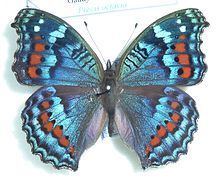Genus Precis Rank Species | ||
 | ||
Similar Precis archesia, Junonia terea, Hypolimnas anthedon, Precis ceryne, Precis pelarga | ||
precis octavia sesamus im schmetterlingshaus bordano karin und wolfgang schm kel
Precis octavia is a species of butterfly in the Nymphalidae family. This butterfly is commonly known as the gaudy commodore and is native to Africa.
Contents
- precis octavia sesamus im schmetterlingshaus bordano karin und wolfgang schm kel
- Description
- Distribution
- Eggs
- Larvae
- Pupae
- Adults
- Subspecies
- References
Description
The southern subspecies (Precis octavia sesamus) has a summer form (natalensis) which is red with black markings, and a winter form (sesamus) which is blue with a line of red markings on the wings. The winter form is slightly larger than the summer form. In both forms the males and females are alike, however the females are slightly larger. Intermediate forms of the gaudy commodore are rare, but display a wide range of mixtures of the wing patterns of both forms.
The northern subspecies (Precis octavia octavia) has only one form which is red with black markings.
Distribution
The southern subspecies of these butterflies (Precis octavia sesamus) is found from the border region of the Eastern and Western Cape in South Africa and along the eastern side of South Africa, to Swaziland, Mozambique, Tanzania and Kenya.
The northern subspecies (Precis octavia octavia) occurs from Sierra Leone to Somalia.
Eggs
The eggs are tiny, rounded, green domes with ribs running up the sides.
Larvae
The larvae are variable; orange, or orange with black bands, or almost completely black. The final-instar larvae are black when reared at the lower temperatures associated with the winter form, and bright orange when reared at the slightly higher summer temperatures.
Larval food plants include Plectranthus esculentus, Plectranthus fruticosus, Rabdosiella calycina, Pycnostachys reticulata and Pycnostachys urticifolia.
Pupae
The pupae hang upside-down and have a knobbley appearance.
By keeping the pupae at different temperatures (warmer or cooler), the two forms of the adults can be produced, while maintaining pupae at ‘boundary’ temperatures produces transitional forms.
Adults
The adults feed on nectar and have an all year flight period, with the winter form found from March to September and the summer form found from October to March.
The two forms are not only different in appearance, but also display different behavior:
The males of the summer form display conspicuous hilltopping, and show both territorial and perching behaviour. They fly between one and two meters off the ground with a medium-fast “flap-flap-glide” motion. They are often found in grasslands.
The male winter form rarely hilltops, has a random flight pattern, and is often found near forests. In cold weather, the winter form hibernates in holes or under overhanging rocks. Up to 35 individuals may gather together in these places.
The summer and winter form have been seen mating with each other.
